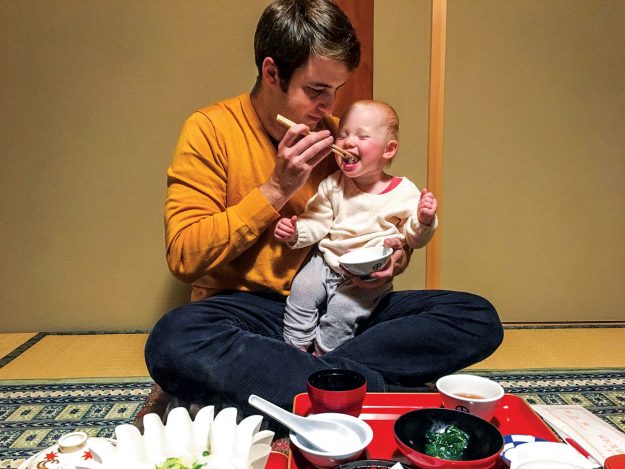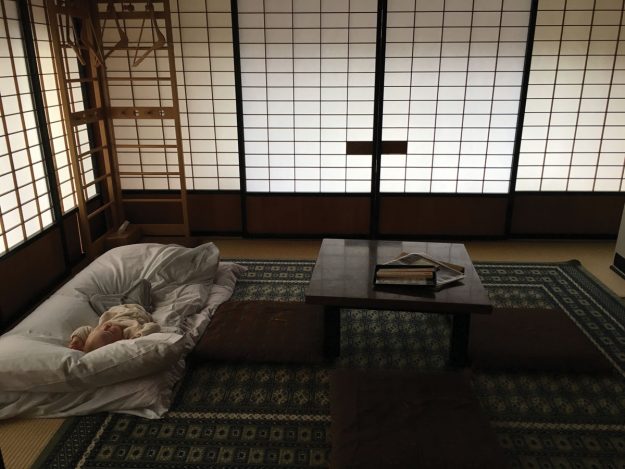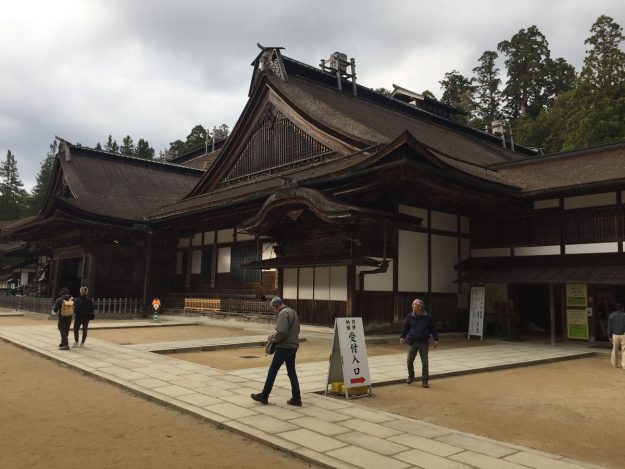One early morning last November, pilgrims sat shoulder to shoulder in a small ritual hall at a Buddhist temple on a remote mountain in Japan. As the presiding monk, dressed in black and yellow robes, tossed pieces of wood into a fire pit and chanted a mantra to three sculpted guardian figures in the front of the room, another monk in the corner beat a taiko drum with increasing intensity. The Buddha burns away the root of our suffering, we were told, as we pray for our wishes to come true. My wife, Liz, and I prayed that our baby wouldn’t start to cry.
Our prayers were soon answered. Our one-year-old daughter, Lila, was transfixed but not afraid. Often squirmy, here she sat completely still as the energy in the room rose. I could see the flames flickering in her wide eyes as she rocked her head to the rhythm of the drum and the chanting, entranced by an ancient ritual.
“She seemed to understand that as well as anyone else,” my wife said after we returned to our room.
We were seeing something, something both strange and compelling, for the first time. Like how Lila must see everything.

My family was staying in Koyasan, a small mountain town in southeastern Japan considered by Shingon Buddhists to be a Pure Land on earth. Founded over 1,200 years ago by the monk Kukai (known honorifically as Kobo Daishi), one of Japan’s most significant religious figures, the town of Koyasan sits in the middle of eight mountain peaks at a site selected because of the geography’s resemblance to a lotus flower. The town is tiny—you can walk across it in less than 30 minutes—but it is home to 117 temples, 52 of which are shukubo, or temples that offer overnight lodging to pilgrims. While we were there, a monk told me that two hundred years ago there were more than two thousand temples on the mountain, but most of them had burned down.
Related: Prickly Priest Comes for One-Star Reviewers
Koyasan was the farthest we traveled from Tokyo during our two-week family trip to Japan. My wife was in Tokyo attending an anime conference for work, and Lila and I were tagging along. Zen literature, art, and practice had been the North Star in my personal meaning-making journey for more than a decade, and I had jumped at the opportunity to give deeper texture to the experiences that Zen had fostered in my life. I wanted to walk through the temples of Kyoto and, though Koyasan was Shingon and not Zen, visit a sacred Buddhist mountain.
It felt good to be so far away from home. The previous year had been a time of returning, settling down, bringing things full circle. After buying my childhood home from my father, I was back living in Portland, Oregon, this time as a dad myself. Depending on the memories that I was drawing on, I was either stuck in a very specific samsaric cycle, or I had just completed the hero’s journey. Either way, since the birth of our daughter I could sense that the opportunities for adventure were fading.
I was either stuck in a very specific samsaric cycle, or I had just completed the hero’s journey.To get to Koyasan from Osaka we would take a train, cable car, and bus. Navigating multiple modes of transportation in a foreign country with a small child gave our journey the intention—and the suffering—of a true pilgrimage. We started the day in Osaka, where we participated in the local tradition of kuidaore, or “eating oneself into total ruin”—ramen, sushi, and an ice cream sandwich with hot marzipan biscuits. Thus we prepared for our day of asceticism. The next morning, we caught the first train to the last stop on the line: Gokurakubashi, or “Heaven’s Bridge.”

On the train, I settled in with a cup of coffee to read the Wikipedia page on Mount Koya. We’re 21st-century pilgrims, I thought, pleased with myself. Lila promptly knocked over my coffee and then started to cry. To occupy her for the rest of the ride, we read her favorite book, Open the Barn Door, which features animal sounds and corresponding animals that are revealed behind cardboard flaps. Who says moo? A cow! We read it over and over. I thought of the famous koan in which a monk asks the master whether a dog has buddhanature, and the master answers: “Mu,” literally meaning “no” but implying “nothingness.” Does a new father and husband approaching middle age, carrying 20 extra pounds (eating himself into ruin) and worried about becoming a cliché have buddhanature? Moo!
I carried another koan with me on my pilgrimage to Koyasan. For three years I’d been practicing with a poem by the 9th-century Chinese Chan master Linji, a koan given to me (and translated) by the Zen teacher John Tarrant:
There is a solitary brightness without fixed shape or form. It knows how to listen to the teachings,
it knows how to understand the teachings,
it knows how to teach.That solitary brightness is you.
As an instruction for how to work with the koan, Tarrant said, “I would just hang out with the brightness and see how it changes you.” Although Shingon Buddhists in Koyasan don’t practice with koans, they believe that any spiritual practice is deepened on Mount Koya, making enlightenment within reach for any visitor.
As the train climbed into green, piney mountains, our car was silent and bright, and I felt a sense of anticipatory joy. About 40 passengers got off the train at Gokurakubashi, where we were supposed to transfer to a cable car to make our final ascent. When we missed the first car by a couple of minutes, however, blissed-out turned to pissed-off in an instant. While Lila quietly napped and I stayed irritably awake, I remembered the Zen story about the farmer who remains equanimous in response to seemingly good and bad news—the lesson being that you never quite know how things are going to shake out. Although I aspired to be like the farmer, I saw myself respond to each small setback with a flare of annoyance followed by sulking.
Not much in my life had been a bigger challenge to my equanimity than being a father. As Liz had said earlier on our trip, “Life with a one-year-old seems to be an ongoing series of coin flips. It’s either heaven or hein.” Since Lila’s arrival, hein had become our shorthand for heinous.
After a short but exhilarating cable car ride straight up the mountain, a cramped and curvy 20-minute bus ride delivered us almost directly to the front of Ekoin, the temple where we were to stay while at Koyasan. A member of the staff took us to our room and, upon learning we were from Oregon, exclaimed, “I wish I could have been there for the eclipse!” Everyone wants to take a pilgrimage to the other side of the world, I thought.
We had two rooms joined together by sliding doors that were decorated with fine brush paintings. Lila toddled down the narrow hall toward a wooden statue of Avalokiteshvara, the crisp November light pouring onto her white sweater. With her bald head and crooked grin, she looked like an unhinged monk leading us to a secret room inside the temple. She banged on the room’s paper walls and thin glass windows. We wondered whether the mountain might be down to 116 temples by morning.
The next day, we left Ekoin to check out Kongobu-ji, the head temple of the Koyasan Shingon school. Lila’s patience was tapped by the time we arrived, so we took turns going inside. One of us would take a brisk contemplative walk among rock gardens and screen paintings that told the life story of Kukai while the other stuffed Lila full of cereal puffs, like we were feeding a parking meter.
While we waited in the courtyard, Lila was set upon by throngs of Japanese tourists reaching out reverently to touch her face and hands. Konnichiwa! She would happily exchange an endless series of bows with any willing partner. Watching her smile and play with the strangers around us, I felt a startling jolt of affection. I felt like I could see a part of her that nobody else was ever going to see.The usually clear line between myself and another had suddenly become blurry. I was shaken out of my reverie, however, when I saw Lila chewing her socks and laughing in a way that was so cute and demented, that I knew she was about to crash.

Back at Ekoin, I abandoned my wife and child to seek enlightenment, just like, you know, the Buddha. Along with about 15 others, I entered Ekoin’s meditation hall, lined with yellow cushions along the tatami mat floor. In the front of the room there was a painting of a mantra in gold: the Sanskrit letter “A” on top of a lotus inside a full moon.
The monks practice a form of meditation technique called Ajikan, which focuses on the sound of the mantra to generate an experience of nonduality, but we beginners were instructed in the basics of calming and focusing the mind by following the breath.
“You can become one with A,” said a young monk at the front of the room. “You can become one with Supreme Buddha. You can become one with this universe. The internal and external can become one.”
Not that it was really in the cards, but I wasn’t sure I wanted to reach this goal. In recent weeks, news from the external world had been particularly hein. A devastating climate report from the UN. Pipe bombs before the US midterm elections. A synagogue shooting in Pittsburgh. I didn’t want that inside me. And there was some internal questioning that I didn’t want to put out into the world. Was settling down the right decision? Were the adventures really over? Now that I was passing the generational baton, had I found my place in the world? Anyway, back to the breath.
My mind wandered to the countless others who had practiced for more than a thousand years on this mountain. What kinds of awakenings were they looking for? Was the energy of their efforts somehow stored in the ground beneath me? Back to the breath.
Related: Great Faith, Great Doubt, Great Determination
After dark, we joined about 30 pilgrims on a nighttime tour of Okunoin Cemetery, the largest cemetery in Japan, with over two hundred thousand graves. Because it houses Kobo Daishi’s mausoleum, it’s considered the most sacred site on Mount Koya.
“We believe Kobo Daishi is not dead,” explained our monk guide. “He is alive and has been meditating for twelve hundred years.” In accordance with this belief, practitioners on the mountain still prepare two meals a day for him.
We walked beneath a canopy of massive cedar trees—some as old as 850 years—and alongside tombstones stacked with the symbols of the five elements in Japanese Buddhist philosophy: earth, water, fire, wind, and consciousness.
“Do you know the shape of your mind?” our guide asked. I peeked at Lila, who had fallen asleep in her baby carrier strapped to Liz. “It’s the shape of the moon,” he told us. “The moon initially looks round, clear, pure, and bright. This is its original shape, but that shape changes every day. And due to changing emotions, so does the mind.”
Stone lanterns chiseled with crescent moons and full moons lit our path. When we arrived at Kobo Daishi’s mausoleum, our guide told us that the real Buddhist teachings are hidden. He could point us toward them, he said, but we would have to discover them for ourselves through meditation. The real Buddhist teachings are hidden in the lotus.The real teachings are hidden in the full moon.
“Is your mind still a full moon?” Liz whispered to sleeping Lila.
The next morning, before the fire ceremony, the temple held an ancestor ceremony, a daily memorial service to offer gratitude to our family lineage. By living virtuously, we were told, we allow our ancestors to rest in peace. My mind went to a memory of Liz’s father, Bill, who had passed away just over two years prior. I felt a pang of sadness that he never got to meet Lila. And that she would never get to meet him. I knelt before an elaborate altar, threw incense onto a small flame, and placed my palms together. As I performed this ritual, somehow my sadness dissipated, at least for the moment, as it gave way to a vivid sense of the continuity of my family lineage. I felt that Bill, that all of us from the past, would be extended into the future through Lila.
Weeks after our return from Japan, Lila started saying her first words. She had a few favorites that steadily held their shape and meaning—book, ball, hat. It was more difficult to predict her response when she was asked, “Who are you?” Sometimes she was “Lila.” Other times she was “Dada.” As was our dog, Jules. More often, though, she babbled and pointed at things around the house: the fireplace, the piano, and especially her cereal puffs. Hidden teachings in plain sight. As she pointed, I dutifully followed her around the house that I had grown up in. Hanging out with my brightness, seeing how it changed me. I put her to sleep in my old room, the room I grew up in. I was a child again: Fuzzy Kitty licking my hair after a shower, me looking out the window at the moon, feeling my smallness for the first time, again.
Most karma is inherited, Lila. A genetic and geographic lottery ticket scratched by the ancestors. Your smile looks like mine. We’ll share a childhood home. Lucky for both of us, you’re half your mama. But some karma is created by what you decide to do with the prize. You are welcome to take up the travel bug, but where will you go? New York City to Mount Koya to Monteith Avenue. Go away. Come back. Go away and come back.
This wax-and-wane lineage is yours.